
|
Fall
Surveys for European Corn Borers in Illinois
|
The
European corn borer, Ostrinia nubilalis (Hübner), was
accidentally introduced into North America from Europe in the early
1900s, probably in shipments of broom corn from Hungary or Italy.
The European corn borer was discovered first in North America near
Boston, Massachusetts, in 1917. By 1952, the European corn borer
had spread throughout most of the major corn-growing areas in the
United States. It first appeared in Illinois in 1939. After it became
established in North America, the European corn borer was recognized
as one of the most economically important insect pests of corn throughout
the Corn Belt. For information about the biology and management
of European corn borers, refer to our fact
sheet.
|
Click
on image for larger version
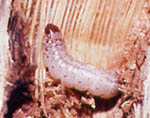
Second-generation
European corn borer
larva in corn stalk
|
History
and Objectives of the Fall Surveys
|

Cornfield
to be surveyed
for second-generation
European corn borers
|
As
the European corn borer spread throughout North America, scientists
became interested in monitoring its spread and estimating densities.
Consequently, entomologists in many north-central States initiated
formal and systematic surveys of second-generation European corn
borers. Entomologists at the University of Illinois and Illinois
Natural History Survey conducted the first survey of second-generation
European corn borers in 36 counties in Illinois in 1941. Fall surveys
have been conducted in essentially the same way every year since
1942. We have annual data from these fall surveys from 1943 through
the present, except for 1997 and 1998, years during which the survey
was not conducted.
|
The objective
of our fall surveys is to obtain estimates of densities of second-generation
European corn borer larvae in crop reporting districts (refer to the Illinois
Agricultural Statistics Service) in Illinois. Not all counties are
sampled every year. The number of counties surveyed in Illinois each year
has varied over time; however, 35-50 counties usually are surveyed within
a given year. Although some counties have been surveyed virtually every
year since 1943, other counties have been sampled less frequently, and
some counties have never been sampled. Results from nearby counties can
be used as reasonable estimates of corn borer densities in counties that
have never been surveyed.
|
The
estimates of second-generation European corn borer densities can
be used to estimate economic impact of corn borers during any given
year. The economic impacts can be compared over time and among counties
and districts in the state. In addition, population trends can be
determined. Although densities of second-generation European corn
borers in a given year suggest potential overwintering population
densities, predictions of densities of corn borers for the following
year are tenuous. Many factors (e.g., weather, natural enemies)
regulate European corn borer populations, so predicting populations
from one year to the next is not an exact science. A review of average
densities of second-generation European corn borers in Illinois
from 1983 through 2002 (20 years) reveals the unpredictability of
populations from year to year.
|
Click
on image for larger version
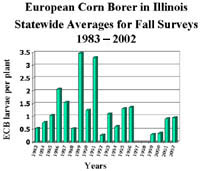
European
corn borer survey
in Illinois, 1983-2002
|
Fall
Survey Procedures
|
Click
on image for larger version
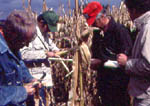
Team of entomologists
and educators surveying
for second-generation
European corn borers
|
The
counties to be surveyed during a given year are determined in advance.
University of Illinois Extension entomologists coordinate the survey
effort, requesting assistance from other state entomologists and
from Extension educators throughout the state. Each surveyor or
pair of surveyors is provided with a list of counties to survey.
|
|
Within
each county designated for surveying, the surveyor drives along
highways and county roads, randomly selecting 10 fields that fairly
represent the different areas of the county. The surveyor walks
into the field at least 50 paces beyond the turn rows and counts
off 25 consecutive plants for examination. The type of information
recorded within each field is shown on the representation of the
form used during the survey. However, not all of this information
has been assembled into the database.
|
Click
on image for larger version
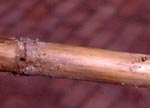
Evidence
of infestation
by second-generation
European corn borers
|
|
Click
on image for larger version
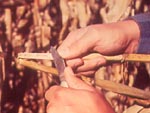
Splitting a corn stalk
in search of second-
generation European
corn borers
|
All
plants infested with European corn borer larvae are counted and
recorded. The stalks, shanks, and cobs of two of the infested plants
are split with a knife, and all borers are counted and recorded.
The stage of development of each European corn borer found is recorded
(instar [I, II, III, IV, and V on the form]; pupa [ P on the form];
and emerged, or empty pupal case [E on the form]).
|
|
The
surveyor also notes the numbers of stalks broken above and below
the ear and the number of ears dropped on the ground. The percentage
of infestation and average number of borers per infested plant are
determined for each field. After all 10 fields have been sampled,
the percentage of infestation and average number of borers per plant
are determined for the county. The county data are used to determine
averages for crop reporting districts.
|
Click
on image for larger version
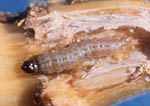
Second-generation
European corn borer
larva in corn shank
|
|

|

|

